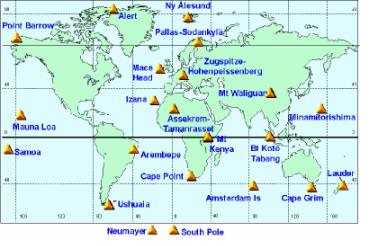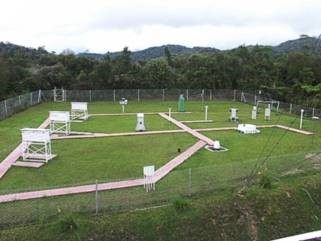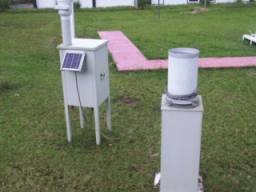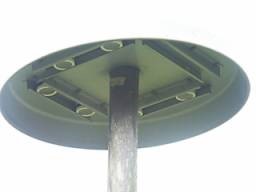Countries in the World Meteorological Organization (WMO) network are encouraged to establish Global Atmospheric Watch (GAW) stations to carry out systematic monitoring of background atmospheric constituents for the purpose of acquiring reliable, high quality data to study and understand regional and global environmental issues such as transboundary haze, acid deposition, climate change and stratospheric ozone depletion.
The Global Atmospheric Watch (GAW) network consists of a worldwide network of strategically-located global, regional and national monitoring stations coordinated by the World Meteorological Organization (WMO) to monitor trends in the atmosphere of Earth. Three GAW stations are operated in Malaysia. These stations are located in Petaling Jaya, Tanah Rata and Danum Valley.
MET Malaysia has established a GAW global station in the Danum Valley, Sabah since November 2003. The Danum Valley is globally, one of the best-known research sites in tropical rainforests in the world. The GAW station, located within a Class 1 forest conservation area, offer an ideal location for investigating atmospheric-biosphere interactions in a tropical rainforest environment, study of long-range transport of pollutants and ability of forests to act as sinks for atmospheric pollutants.
A set of observations is currently on-going at the GAW stations to address regional issues such as acid deposition, transport of trace gases, physical and characteristic of aerosols and local UV radiation. A comprehensive acid deposition programme exists at the GAW sites to monitor both wet and dry deposition. Aerosol mass concentration and physical properties are also monitored using a number of instruments including High Volume Air Samplers, Multiple Angle Absorption Photometer, Nephelometer, Precision Filter Radiometer (PFR) and the Tapered Element Oscillating Microbalance Instrument for real-time measurements. Ozone profile and total ozone measurements are conducted at KLIA and Petaling Jaya respectively, while surface ozone is monitored both at Tanah Rata and Danum Valley.
What is GAW ?
The GAW consists of a worldwide network of strategically-located global, regional and national monitoring stations coordinated by the WMO. Formally established in 1989, GAW integrated a number of existing WMO monitoring activities in the field of atmospheric environment. These were the WMO Global Ozone Observing System (GO3OS) that was started in the 1950s and the Background Air Pollution Monitoring Network (BAPMoN) that commenced in the 1960s and included measurements of important greenhouse gases (GHGs). The data collected are particularly essential in understanding the relationship in understanding between changing atmospheric composition and human-induced changes in global and regional climate. The GAW activities also focus on the monitoring and research aspects of long-range atmospheric transport and deposition of potentially harmful substances over terrestrial, freshwater and marine ecosystems, and the natural cycle of chemical elements in the global atmosphere-ocean-biosphere system, and possible anthropogenic influences thereon.

There are presently 300 GAW stations in operation of which more than 200 are GAW regional stations operated by more than 60 countries for monitoring and assessing regional environmental problems. These include estimates of air pollution in rural areas, the acidity of precipitation, the deterioration of ecosystems and airborne pollution of the seas. Many of these regional GAW stations measure increases in surface ozone, which also has an impact on regional climate.
There are presently 22 fully operational GAW global stations with complete programmes. Measurements at the global stations include total ozone (O3), carbon dioxide (CO2) and other greenhouse gases, solar radiation, total aerosol load, composition of atmospheric particles and other meteorological parameters.
Who operates the GAW stations?
The operation of the GAW monitoring network relies largely on the activities of the meteorological services of the countries that operate the monitoring stations. A number of these stations are operated in cooperation with other research and academic institutions.
Benefits from the GAW network
Since the late 1970s, measurements from the GAW surface stations have been augmented by measurements from satellites using special equipment such as the Total Ozone Mapping Spectrometer (TOMS). Ozone data from the GAW network information from the satellites together provide the only dataset available for the determination of the long-term trends of ozone concentrations. These have been highly instrumental in providing the basis for the adoption of the Vienna Convention for the Protection of the Ozone Layer and the associated Montreal Protocol on Substances that Deplete the Ozone Layer and its Amendments.
The GAW will also play a major and increasing role in the long-term validation of satellite determinations of trace gas concentrations, since continuous validation is critical for reliable determination of trends.
The GAW data and resulting assessments thus provide crucial input on the state of atmospheric composition to numerous users. These include individual scientists, research organizations, Governments, policy makers, and the WMO/UNEP Intergovernmental Panel on Climate Change (IPCC). They are also crucial to the implementation of relevant international conventions, such as the United Nations Framework Convention on Climate Change (UNFCCC), and the Vienna Convention for the Protection of the Ozone Layer.
The monitoring programme at the GAW Station in Tanah Rata
The monitoring programme at the Tanah Rata GAW station includes the following parameters:
Rainwater chemical composition
Precipitation chemistry is the simplest way to obtain an indication of pollution in the lower atmosphere. In essence, air pollutants are scavenged by the precipitation process and delivered to the surface in the rain. In the early part of the century, acidity of precipitation was of major concern in Europe and North America but in recent times the concern has now spread to many regions of the world, especially Asia. Economic development and population growth in developing countries are identified as the main factors contributing to increased emissions and deposition of acidic pollutants. This acidity was known to have adverse effects on terrestrial and aquatic environments, ranging from acidification of soils and inland waters (causing vegetation decline and fish kills) to the damage of buildings and monuments. There is also increasing recognition that the nitrogen nutrients delivered to the surface by precipitation may contribute significantly to the over-enrichment of ecosystems and especially to the eutrophication of coastal waters.
The measurement of rainwater chemical composition at the GAW station in Tanah Rata is to evaluate regional contributions of selected chemical compounds in precipitation, to determine their spatial and temporal distributions, to assess the influence of human activities on the composition of the atmosphere and to improve knowledge of physicochemical processes related to the atmospheric transport and deposition of acidic pollutants.
Rainwater is collected using the Ecotech Wet-only Rainwater Sampler. This instrument consists of a tipping bucket precipitation gauge, collection funnel, sample bottles unit and solar panel as power unit. When the sensor detects precipitation, the lid covering the collection funnel opens and initiates sampling of rainwater. The collected rainwater is stored in bottles inside the instrument. The Tanah Rata Wet-only Rainwater Sampler is programmed to collect rainwater samples over a period of 7 days. The samples are sent to the Department of Chemistry for chemical analysis.
Reactive Gases
Dry deposition of atmospheric pollutants remains an elusive contribution to the total deposition of pollutants from the air to natural surfaces. In the absence of suitable direct dry deposition measurement techniques, dry deposition, which is often of major importance near pollution source areas, is estimated by using measurement data on concentrations of major pollutants in air.
Sulphur dioxide is an important gaseous pollutant as it is precursor of acid deposition. It is therefore a standard measurement in most regional GAW stations. It has a lifetime of hours to days. The natural sources of SO2 include the sea, volcanic activity and biomass decay process but the major anthropogenic source is from the burning of fossil fuels.
Nitrogen oxides and volatile organic compounds (VOCs) are important precursors for ozone and other oxidants in the troposphere. There are no acceptable methods for measurement of the very low concentrations of nitrogen oxides present in the atmosphere due to their rapid conversions between their compounds. Since anthropogenic activities constitute a large source of nitrogen oxides, measurements at remote locations are necessary to observe changes in concentrations.
In Tanah Rata, sulphur dioxide concentrations are measured continuously using the Monitor Lab ML9850 Sulphur Dioxide Analyzer. The instrument consists of a discharge lamp, an optical band-pass filter and a photomultiplier tube. The operation of this instrument is based on classical fluorescence spectroscopy principles. Sulphur dioxide exhibits a strong ultraviolet absorption spectrum between 200 and 240 nm. Absorption of photons at these wavelengths results in the emission of fluorescence photons at wavelengths between 300 and 400 nm. The amount of fluorescence emitted is directly proportional to the SO2 concentration.
Two other methods are also used to measure gaseous concentration at Tanah Rata, namely passive samplers and filter packs. Passive samplers are small and light and do not require electricity. The sampler contains a sink (impregnated filter) for certain gases. For example, in the case of sulphur dioxide, the filter is impregnated with 4% potassium carbonate and 2% ethylene glycol in water. The driving force is the Brownian molecular motion or laminar diffusion. The mass transport to the impregnated filter is proportional to the ambient concentration and dimensions of the sampler. After exposure for a period of one week, the passive samplers are sent to a chemical laboratory where the filters are chemically analyzed.
The filter pack consists of a stack of filters for sampling a number of gases at the same time. Air is drawn through the pack at a known rate using a low volume air pump for a period of one week. The filters are then analyzed using the same procedures as for the passive samplers.
Aerosol load and chemical composition
Atmospheric aerosols are important for a diverse range of issues from global climate change to regional and local scale air quality. The climate impact of aerosols is a result of both direct radiative effects and indirect effects on cloud properties. Regional problems include potential impacts on human health and mortality. Major sources include both urban/industrial emissions and smoke from biomass burning.
The Tanah Rata GAW station measures total suspended particulate (aerosol) load using the Sierra Andersen High Volume Air Sampler. This instrument consists of a motor, which draws air through a glass fibre filter at a known rate of 1120 litres/min, and the atmospheric aerosol concentration is then determined by calculating the difference in weight of the filter before and after sampling.
Aerosols of diameter less than 10 micron (PM-10) are collected on telfon filters using the Ecotech SolarVol Particulate Sampler which operates at a much lower flow rate of 4 litres/min. The concentration of PM-10 aerosols is determined in the same manner as with the High Volume Air Sampler. The samples are then sent for analysis to determine its chemical composition.
Surface Ozone
In the stratosphere, ozone is produced by the action of UV radiation upon oxygen molecules. It is at its maximum between 18 and 23 km altitude. Ozone absorbs a large part of the biologically harmful solar UV radiation. Scientists have confirmed that stratospheric ozone losses observed since the early 1970s are mainly due to human-produced chlorofluorocarbons (CFCs) and halon gases in the atmosphere. The ozone decline is most dramatic in the Antarctic spring and the resulting thinning of the polar ozone layer is commonly referred to as the ozone hole
Surface ozone plays a central role in physical, chemical and radiative processes in the troposphere. It has become apparent that surface ozone significantly influences the formation of photochemical smog and is an irritant with effects both on the biota and human health. The measurement of surface ozone is therefore important to characterize the global background distribution.
At Tanah Rata, surface ozone is measured continuously using the Monitor Lab ML9811 Ozone Analyzer. Ozone exhibits strong absorption in the ultraviolet spectrum at 254 nm. The instrument exploits this absorption feature to accurately measure ozone concentrations. The instrument consists of a mercury vapour lamp, an absorption cell and a photodiode, which acts as the detector.
An understanding of the climatology in the area immediately around and especially upwind of the GAW station is necessary for the interpretation of any long-term data that will be collected at the site.
Temperature, wind speed and direction, pressure, relative humidity/dew point and amount of precipitation are the standard meteorological parameters that are recorded at GAW stations. A continuous and in-situ measurement programme of meteorological parameters is necessary to complement and interpret changes in individual air quality parameters over time as well as their chemical and dynamical transformations at the regional site.
The meteorological instrumentation at Tanah Rata consists of the standardized equipment used in all climatological stations throughout the country, namely:
Temperature | Thermometer |
Wind speed and direction | Anemograph |
Pressure | Barometer |
Relative Humidity | Wet and dry thermometer bulb |
Precipitation | Rain gauge and rain recoder |
Monitoring and research activities of the Global Atmosphere Watch station, Bukit Atur, Danum Valley, Sabah

The World Meteorological Department (WMO) Global Atmosphere Watch (GAW) Station in Danum Valley, Sabah was established by the Malaysian Meteorological Department in collaboration with and support from Yayasan Sabah for the monitoring of background concentrations of atmospheric parameters.
The construction of the GAW station began in 2002 was completed at the end of 2003 and began operations in 2004. The station was established to make reliable, comprehensive observations of the chemical composition and selected physical characteristics of the atmosphere on a global scale and to provide the scientific community with the means to predict future atmospheric states.
The Danum Valley GAW station is one of 23 such global stations in the WMO GAW monitoring network. This monitoring network conducts systematic monitoring of atmospheric chemical composition and related physical parameters on a global and regional scale. The network also conducts analysis and assessment in support of environmental conventions and future policy developments.
Monitoring Activities
Since the establishment of the GAW Station in 2004, a number of monitoring systems were installed and activities initiated. The systems at the GAW station consists of
Lo-Flo Mark II Carbon Dioxide System
Tapered Element Oscillating Microbalance (TEOM) System
Multi-Angle Absorption Photometer (MAAP)
Nephelometer
Ecotech Wet-Only Sampler
Filter Pack Sampling System
Persistent Organic Pollutant Passive Sampler
Surface Ozone Analyser
Automatic Weather System (AWS)
Vertical Wind Profile System
Providing a link between the system at the station with MET Malaysia headquarters in Petaling Jaya and other internet terminals is a VSAT communication system.
Future plans for the station include greenhouse gas (GHG) monitoring by flask sampling. Measurement of aerosol optical depth is expected to begin in April 2007 and monitoring of GHG in 2008.
Gases that absorb radiation and trap heat in the atmosphere are called greenhouse gases (GHG). GHG consist of carbon dioxide (CO2), methane (CH4), nitrous oxide (N2O) and fluorinated gases, such as chlorofluorocarbon (CFC), hydrofluorocarbon (HFC) and haloalkanes (halons). Among these different GHG, CO2 has the most significant impact upon global warming due to its abundance and long life time, as it can remain for a few centuries in the atmosphere. Although CH4 is about 21 times more efficient at absorbing solar radiation compared to CO2, the impact upon global warming is much less due to its much shorter life time of around 10 years.
Carbon dioxide (CO2) concentration at three heights at the Danum Valley GAW Station is measured by the Australian made CSIRO Lo-Flo Mark II Carbon Dioxide analyzer which is an integrated system constructed based on the LI-COR Inc. non dispersive infrared (NDIR) analyzer optical bench.
With the data collected by this system, beginning from 2006, CO2 and greenhouse gas data from the GAW site in Danum Valley are submitted every six months to teh WMO World Data Centre for Greenhouse Gases in Japan.
Tapered Elemental Oscillating Mass (TEOM) System
The TEOM system made by Rupprecht and Patashnick Co. Inc. is a real time instrument for measuring the particulate concentration of particulate smaller than 10 micron in diameter in outdoor and indoor ambient air. It is true gravimetric instrument that draws air through a filter at a constant flow rate, continuously weighing the filter and calculating near real-time mass concentration.
Nephelometer
The Ecotech manufactured M9003 Nephelometer is designed for the measurement of the coefficient of light back scattering due to suspended particulate matter in air. Measurement of this parameter gives an indication of the visibility of the surrounding area automatically without the need for an observer. Light back scattering amount is also an important measure of the aerosol concentration in the atmosphere.
Ecotech Wet-Only Sampler
The Ecotech wet-only rainwater sampler was specially designed for acid rain monitoring studies. Installed since the station was established, the wet-only sampler is used mainly to monitor rain water composition and acidity in remote location like Danum. Rainwater samples collected by the sampler is sent to the Department of Chemistry for analysis as there no laboratory facilities in Danum for the analysis of such low concentration chemical species in rainwater.
Filter Pack Sample System
The filter pack sample system is for monitoring dry acid deposition and forms part of the EANET program to monitor dry acid deposition at a remote site. The filter pack method has been adopted for dry deposition monitoring programs in many countries.
The filter pack samples aerosols which are collected at the first of four stages in the filter pack sampler. The second stage filter is designated to collect nitric acid in the gas phase and the third stage collects sulphur dioxide and hydrochloric acid. Finally, the fourth stage of the filter pack collects ammonia gas. The collected aerosols and gas species are analysed and its concentration in air is determined.
Persistent Organic Pollutant Passive Sampler
Monitoring persistent organic pollutants (POPs) by passive sampling is part of the Global Atmospheric Passive Sampling (GAPS) study which showed that passive air samplers are viable collectors for assessing the worldwide distribution of POPs, by siting them across seven continents.
Danum Valley is one of the global sites selected for the study which started in 2005 and entering into the third year of the study which produced some interesting results on the transport and concentration POPs in the atmosphere. In addition, these passive samplers are becoming the official method of looking at the spatial distribution and long term trends of POPs.
Surface Ozone Analyser
As tropospheric ozone is the third important greenhouse gas and ozone near the surface is a toxic gas to human health and vegetation, the METMalaysia has embarked on a program to monitor and study the impact of this gas in the country including at a remote location such as Danum Valley. With this objective, the METMalaysia has just installed the latest Thermo Environment 49i Ozone Analyser at the GAW station to monitor the hourly surface ozone concentration at this remote site.
Automatic Weather System (AWS)
The AWS measure the routine meteorological parameters of the GAW station site. Meteorological measurements made by the AWS represent the meteorological conditions of the GAW site and its area surrounding it. Meteorological parameters measured and recorded every minute are (i) surface wind velocity (ii) temperature (iii) relative humidity and (iv) solar radiation.
halaju angin permukaan
suhu
kelembapan bandingan
radiasi solar
Vertical Wind Profile System
The vertical wind profile system consist of a ultrasonic anemometer for measuring three dimensional wind velocity, two cup anemometers for measuring horizontal wind velocity and three couples for measure temperatures at three different levels on the meteorological tower.
This system is part of the meteorological monitoring program of the OP3 project for studying the vertical flux of emission from the surface boundary layer of the area.










